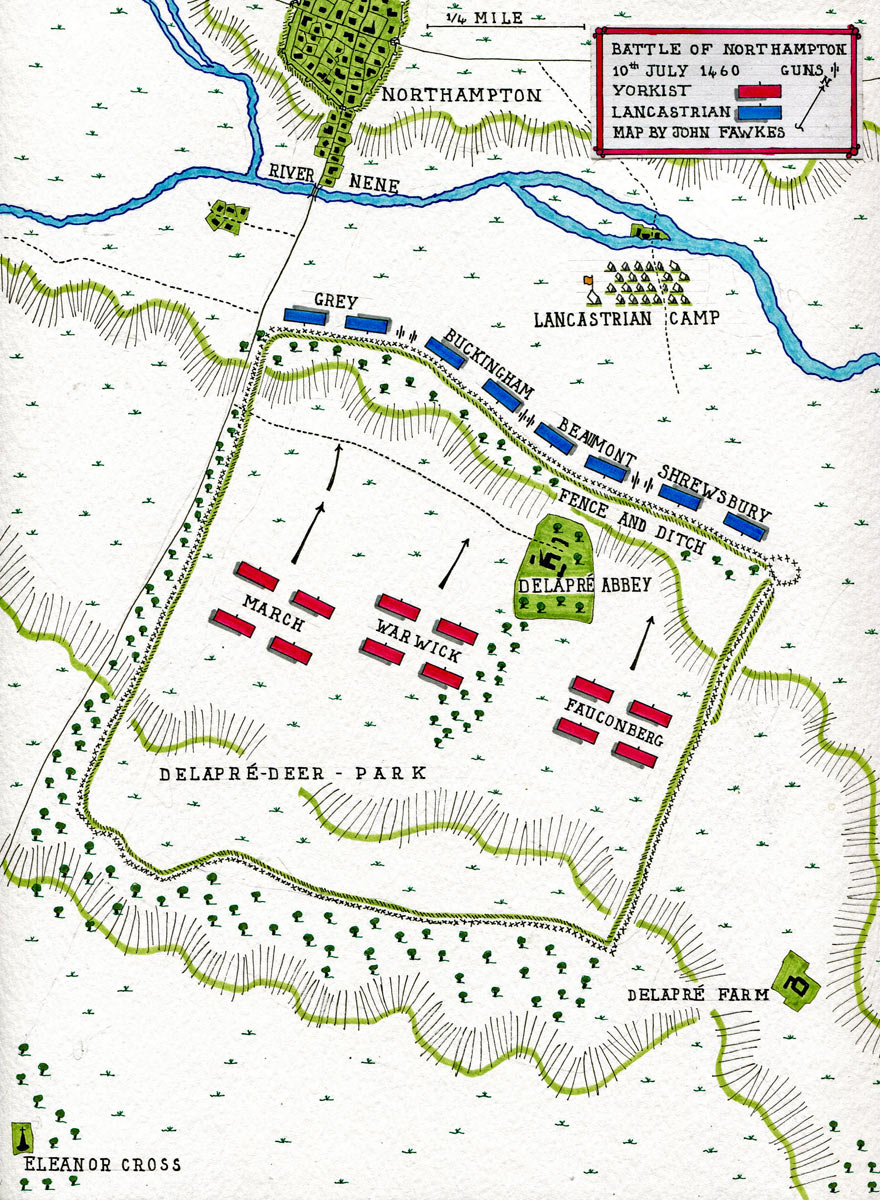King Henry VI, captured for a second time by the Yorkists, after the crushing defeat of the Lancastrians at the Battle of Northampton, fought on 10th July 1460
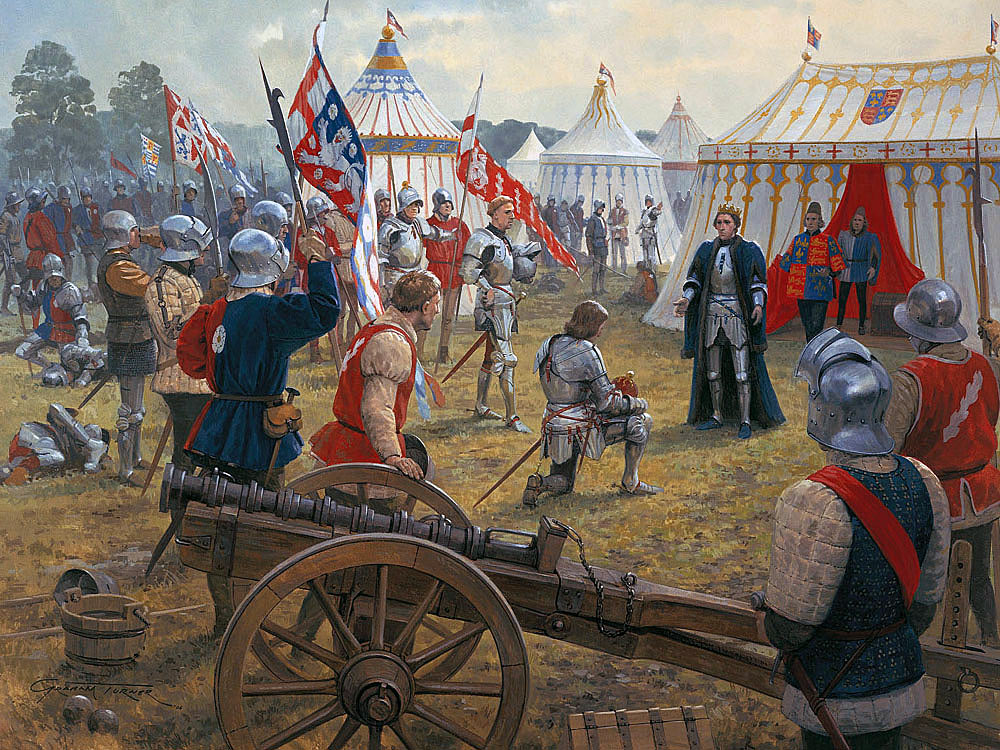
Earl of Warwick kneels to King Henry VI after the King’s capture by the Yorkists at the Battle of Northampton on 10th July 1460 in the Wars of the Roses: picture by Graham Turner
The previous battle in the British Battles series is the Battle of Blore Heath
The next battle of the Wars of the Roses is the Battle of Wakefield 1460
Battle: Northampton
War: Wars of the Roses

Duke of Buckingham, Lancastrian commander, killed at the Battle of Northampton on 10th July 1460 in the Wars of the Roses
Date of the Battle of Northampton: 10th July 1460
Place of the Battle of Northampton: To the south of the county town of Northampton in the English southern midlands
Combatants at the Battle of Northampton: Lancastrians against the Yorkists
Commanders at the Battle of Northampton: The Duke of Buckingham commanded the Lancastrian army.
The principal Yorkist commanders were; Richard Neville, Earl of Warwick, known as ‘Warwick the Kingmaker’, Edward, Earl of March (later King Edward IV) and Lord Fauconberg.
Size of the armies at the Battle of Northampton: The Lancastrian army probably comprised some 5,000 men, the Yorkist army some 8,000 men.

Earl of Warwick, Yorkist commander at the Battle of Northampton on 10th July 1460 in the Wars of the Roses
Winner of the Battle of Northampton: The Yorkists resoundingly defeated the Lancastrian army, capturing King Henry VI.
Uniforms, arms and equipment at the Battle of Northampton: The senior commanders and their noble supporters and knights rode to battle on horseback, in armour, with sword, lance and shield.
Their immediate entourage comprised mounted men-at-arms, in armour and armed with sword, lance and shield, although often fighting on foot.
Because the Battle of Northampton centred on a fortified fence and ditch, it is likely that most of those involved fought on foot.
Both armies comprised strong forces of longbowmen.
Handheld Firearms were beginning to appear in numbers on the battlefield, but were still unreliable and dangerous to discharge.
Artillery, although widely used in warfare, was heavy, cumbersome and difficult to move and fire.
The Lancastrians mounted a number of cannon at the Battle of Northampton, along the line of their field fortifications, but the ammunition was doused by the sudden squall of rain, rendering the canon unusable.
The end of the Hundred Years War caused numbers of English and Welsh men-at-arms and archers to return to their home countries from France. The wealthier English and Welsh nobles were able to recruit companies of disciplined armed retainers from these veterans, forming the backbone of their field armies.
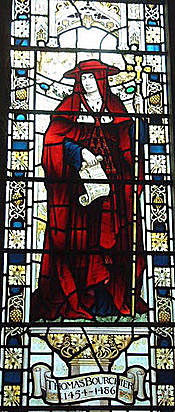
Cardinal Archbishop Bouchier: memorial window in Sevenoaks Church, Kent: Battle of Northampton on 10th July 1460 in the Wars of the Roses
Background to the Battle of Northampton: The Yorkist capture of King Henry VI at the First Battle of St Albans was followed by a period of Yorkist supremacy in the government of England.
This period of Yorkist supremacy came to an end in April 1459, when the Queen, Margaret of Anjou, gathered an army at Leicester, formed a parliament and ordered the arrest of the Yorkist leaders.
The Duke of York, after the Yorkist victory at Blore Heath, went to Ireland as the Lord Lieutenant, while the Earl of Warwick was serving as Captain of the English garrison of Calais, the last French town in English hands following the Hundred Years War.
On 25th June1460, the Earl of Warwick, with Edward, Earl of March, landed from Calais at Sandwich and marched to London.
The Lancastrian Duke of Buckingham left London with his troops and marched north to the Midlands, while London, substantially a Yorkist city in sentiment, opened its gates to Warwick and March.
In London, Warwick assembled a Yorkist army. Among the notables to join him was the Duke of Norfolk.
In the meantime, Queen Margaret was assembling her Lancastrian forces in the North with her son, Edward, Prince of Wales.
Queen Margaret’s chief supporter, the Duke of Buckingham, moved his Lancastrian army to Northampton, where he awaited the Yorkist advance. With Buckingham’s army was the King, King Henry VI, a weak man, subject to periods of reclusion.
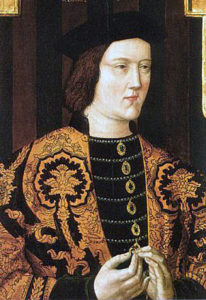
Edward, Earl of March, later King Edward IV, Yorkist commander at the Battle of Northampton on 10th July 1460 in the Wars of the Roses
The Yorkist commanders, Warwick, March and Fauconberg, faced a problem. While King Henry VI was a Lancastrian, he was the crowned King of England. Military action against an army that the King appeared to command amounted in the eyes of many to rebellion. The Yorkists could not be sure that their own troops would mount an attack on a force fighting under the Royal Standard.
The Yorkist leaders repeatedly maintained that they were not in rebellion against King Henry VI, but merely wished to remove him from the influence of misguided advisers, the Lancastrian nobles.
While in London, Warwick persuaded Archbishop Bouchier of Canterbury and a number of senior bishops to accompany the Yorkist army.
Warwick marched north on 4th July 1460, leaving a strong force in London to cover the Tower of London, still held by a Lancastrian garrison, commanded by Lords Scale and Hungerford.
Archbishop Bouchier and the bishops rode ahead of the main Yorkist army, intending to see King Henry VI and persuade him that he should see the Earl of Warwick in private consultation. They reached Northampton on 9th July 1460, but Buckingham prevented the bishops from having access to King Henry VI.
Warwick and the Yorkist army approached Northampton on the evening of 9th July 1460.
The Yorkists found the Lancastrian army entrenched on the northern boundary of the Deer Park of Delapré Abbey. To the north of the abbey, the River Nene ran from west to east. The town of Northampton lay on the far side of the River Nene. The main road from London ran from south to north to the west of the abbey.

Demolition of the Eleanor Cross in Cheapside, London, in May 1640: Battle of Northampton on 10th July 1460 in the Wars of the Roses
The Delapré Abbey Deer Park comprised a rectangle, bordered by a ditch and fence. The Abbey lay in the centre of the park.
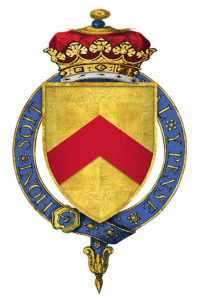
Coat of Arms of the Duke of Buckingham, Lancastrian commander, killed at the Battle of Northampton on 10th July 1460 in the Wars of the Roses
The combined ditch and fence, the ditch being on the inner side, existed to keep the deer in and poachers out and formed a barrier some 10 feet in height.
The Lancastrian army was positioned along the northern boundary, facing into the estate.
At each corner of the Deer Park were small enclosures, which the Lancastrians fortified.
The Lancastrians possessed guns which were in position along the northern perimeter fence.
The Yorkist approach to the Lancastrian position lay through the Delapré Abbey Deer Park, an area of grazing and copses.
Military leaders of the time were little concerned with tactical subtleties. Their armies were bands of men thrown together at short notice, from different areas, with little sense of cohesion and only a vague notion of the leaders they were fighting for. Soldiers’ loyalties were to their immediate commanders, for whom they were prepared to fight.
The task given to such armies needed to be simple. Complicated tactical plans were neither feasible nor usually considered. Where a tactical ploy is discernible in a battle of the time, it is more likely to have arisen through chance than design.
The Yorkists intended a frontal assault on the Lancastrian position along the northern perimeter of the Deer Park. The Lancastrian plan was to defend the position.
Convention of the time required there to be consultation between the warring sides, to see if their issues might be settled without combat. This was particularly important for the Yorkist leaders, to ensure that their own troops did not feel that an unnecessary battle was incurred, against an army carrying the Royal Standard and accompanied by the King.
The Earl of Warwick’s herald rode ahead of the Yorkist army and attempted to open a parley with the Duke of Buckingham, to persuade him to give Warwick private access to King Henry VI. The herald was rebuffed.
———————————-
Account of the Battle of Northampton:
Behind the fence and ditch on the northern perimeter of the Delapré Abbey Deer Park, the Lancastrian army was formed with the Earl of Shrewsbury’s men on the left and Lord Beaumont’s men next to them, in the left centre.
The Duke of Buckingham’s armed retainers and followers stood on the right centre.
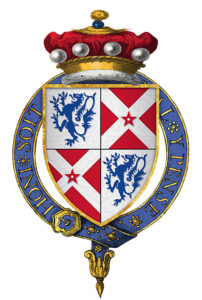
Coat of Arms of Lord Fauconberg, Yorkist commander at the Battle of Northampton on 10th July 1460 in the Wars of the Roses
The Lancastrian right flank was held by the troops commanded by Lord Edmund Grey of Ruthin. Lord Grey’s men wore his badge of a Black Staff on a Green Field. Grey’s banner carried the same device.
The Lancastrian line was reinforced by the presence of a number of guns.
As the Yorkist army arrived from the south, it was put into battle array by Lord Scrope and Lord Stafford, riding ahead and already on the field.
Lord Fauconberg’s van filed off to form the right wing of the Yorkist attack.
The Earl of Warwick’s men took the Yorkist centre and Edward, Earl of March the Yorkist left.
It took until midday on 10th July 1460 for the Yorkist army to be in place.
Once the Yorkist army was formed up, the Earl of Warwick rode along the line, speaking to the Yorkist soldiers and emphasising to them that they were not fighting against King Henry VI. Their purpose was solely to overcome the King’s corrupt Lancastrian advisers and remove them. Warwick meant the Duke of Buckingham, the Earl of Shrewsbury, Lord Egrement and Lord Beaumont.
Warwick returned to his men in the centre and the Yorkist attack began.
As the Yorkists advanced there was a sudden sharp squall, with heavy rain sweeping across the battlefield.
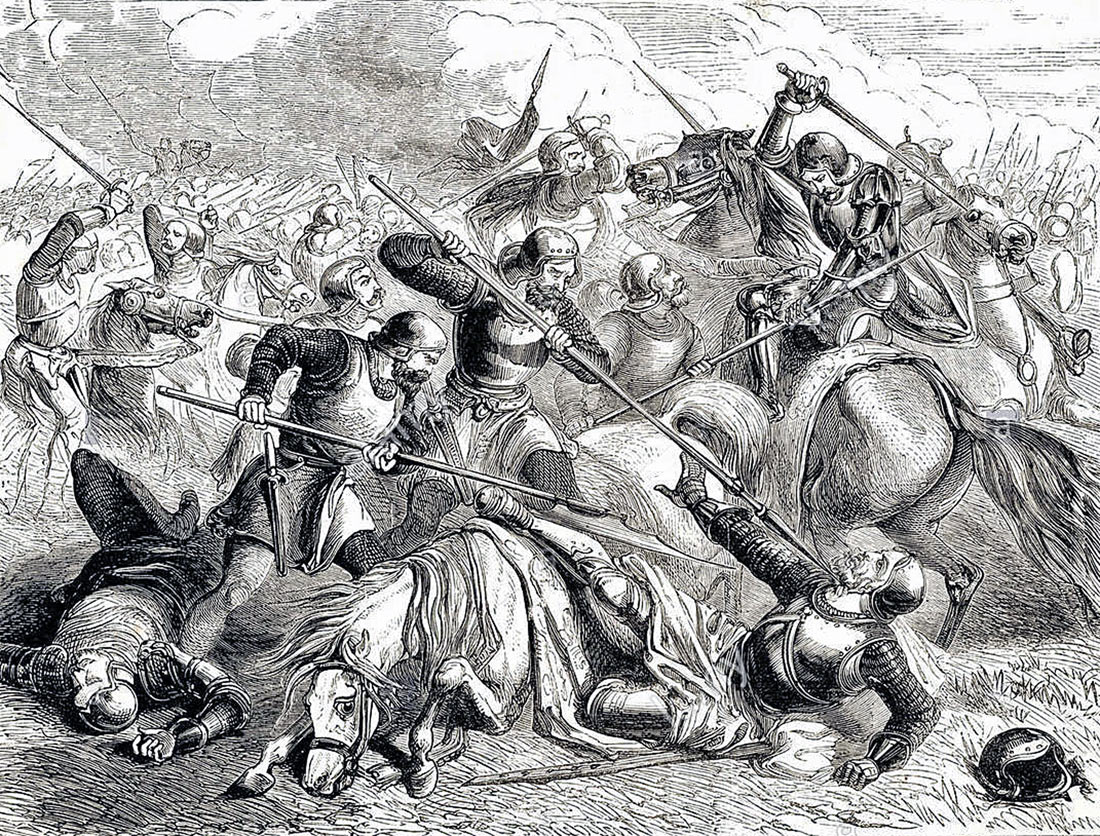
Death of the Earl of Shrewsbury at the Battle of Northampton on 10th July 1460 in the Wars of the Roses
On the Lancastrian side, the guns were ready to fire. While the discharges of ball and the early form of grape shot were unlikely to do a great amount of damage to the Yorkists, due to the slow rate of fire, the deep booms and clouds of smoke from the canon shots would be a great morale booster for the Lancastrian troops and frightening for the attacking Yorkists.
By each gun, the gun powder charges were in cloth cartridges and open barrels contained the charges to be ladelled into the touch holes.
The downpour of rain soaked the charges and powder in the open barrels, ensuring that the guns could not be fired, with a heavy adverse impact on Lancastrian morale.
It was still a hard-fought battle and the result hung in the balance for some while.
The Yorkists were subject to a discharge of longbow arrows as they advanced on the Lancastrian line.
On the Yorkist right and in the centre, Fauconberg’s and Warwick’s men reached the ditch and fence and attempted to storm them but were repelled.
If this pattern was repeated with Edward, Earl of March’s men on the Yorkist left, the battle would have gone to the Lancastrians and the Yorkists forced to withdraw, many of their men deserting and returning home.
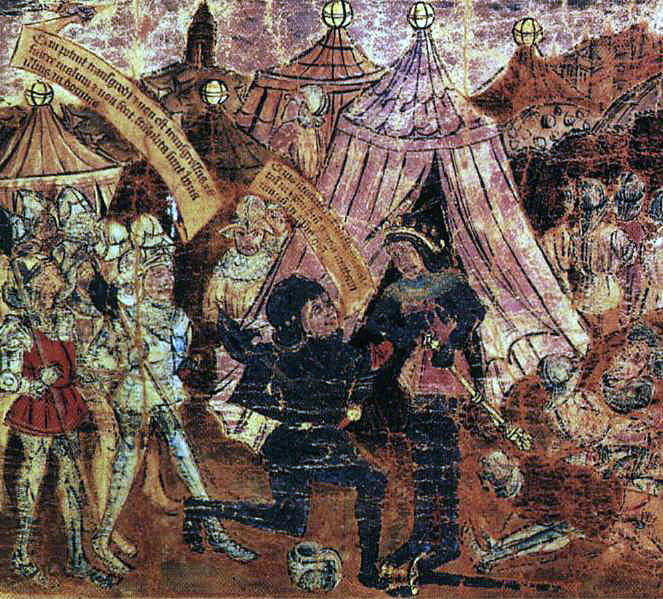
Earl of Warwick kneels to King Henry VI after the King’s capture by the Yorkists at the Battle of Northampton on 10th July 1460 in the Wars of the Roses
The Earl of Warwick was in secret communication with Lord Edmund Grey of Ruthin. An offer of land to extend Lord Grey’s estates was sufficient to cause him to change sides and to conceal his defection until the battle.
Lord March warned his men not to attack any man wearing the Grey badge of the Black Staff on a Green Background.
Grey’s men were expecting to change sides and as March’s men reached the ditch and fence, instead of meeting a hail of arrows and blows from above, they were assisted across the ditch and through gaps in the fence by the erstwhile Lancastrian defenders.
The combined forces of Lord March and Lord Edmund Grey turned on the remaining Lancastrian forces and rolled them up from their right flank.
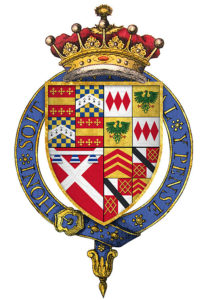
Coat of Arms of the Earl of Warwick, Yorkist commander at the Battle of Northampton on 10th July 1460 in the Wars of the Roses
As the Lancastrians were driven away from their defensive line, the Yorkists of Warwick and Fauconberg burst through and joined the attack.
The Lancastrian army dissolved in flight, many men in armour drowning as they attempted to cross the Nene River to escape.
After a vigorous pursuit by the victorious Yorkists, the battle ended and the Yorkist army gathered at Delapré Abbey.
Lord Fauconberg supervised the collection of the casualties left on the battlefield. The prominent bodies were put aside to be collected by their families for burial in the family vaults. The common soldiers were buried in a mass grave.
Casualties at the Battle of Northampton: All four of the principal Lancastrian leaders died in the battle; the Duke of Buckingham, the Earl of Shrewsbury, Lord Egrement and Lord Beaumont.
King Henry VI was overcome by a Yorkist man at arms, who then recognised his prisoner and took him to the Earl of Warwick. Warwick declared his loyalty to the King and sent him to be kept in safety in Delapré Abbey.
Around 300 Lancastrians were killed in the Battle of Northampton, with probably a further 200 killed in the pursuit. Some 2,000 were wounded and captured.
The Yorkists suffered around 100 dead and probably 500 wounded.
Follow-up to the Battle of Northampton: Warwick and the Yorkist leaders remained in the Delapré Abbey with King Henry VI for three days, before returning to London.
They found the Tower of London still held for the Lancastrians.
Warwick offered terms that the Tower garrison and its leaders could leave in safety, provided the Tower was immediately surrendered without damage.
Lord Hungerford accepted the terms and was permitted to returned to his estates.
Lord Scales attempted to escape but was recognised and killed by Thames boatmen.
Hearing of the victory at Northampton, the Duke of York returned from Ireland. York and Warwick assembled a Parliament in London, which expressed support for the Yorkist cause.
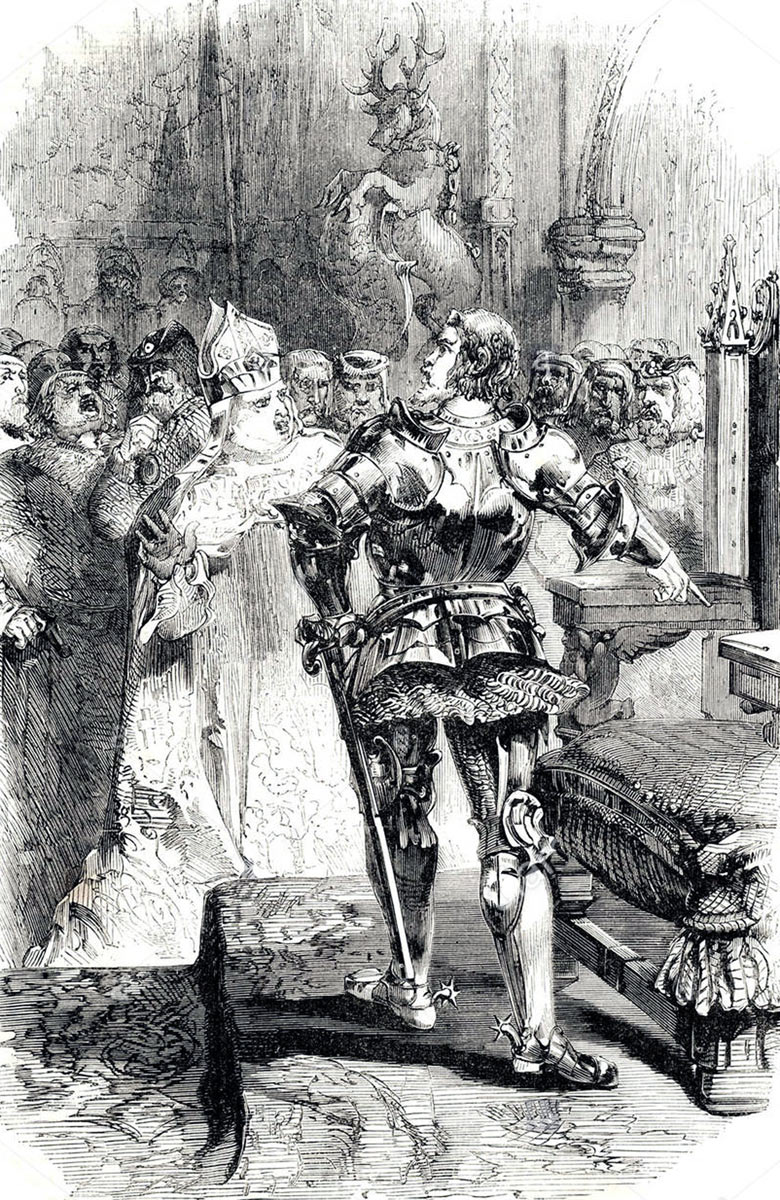
Richard, Duke of York, claiming the Throne of England in the Parliament held after the Battle of Northampton on 10th July 1460 in the Wars of the Roses
The Parliament met on 10th October 1460. At the opening ceremony, the Duke of York attempted to assert a claim to the throne of England. This attempt was not well received by the assembled nobles and gentry, or even by his supporter and kinsman the Earl of Warwick.
Meanwhile, Queen Margaret was marching south from Scotland with a band of mercenaries. As she progressed, her army was swelled by her Lancastrian supporters.
The Duke of York marched north from London to confront Queen Margaret and their armies met at the Battle of Wakefield.
Anecdotes and traditions from the Battle of Northampton:
- The Eleanor Cross stands in the south-west corner of the Northampton battlefield, one of a line of twelve such crosses erected by King Edward I across England, to mark the progress of the body of Queen Eleanor from Lincoln, where she died, to London. Bishop Bouchier and the other bishops are said to have watched the Battle of Northampton from the Eleanor Cross. Another cross, situated in London, was the subject of controversy in the times leading up to the English Civil War and was torn down by the Puritans as a symbol of idolatry in May 1640.
- Following his timely change of side from Lancastrian to Yorkist, during the Battle of Northampton, Lord Edmund Grey was rewarded with the grant of the Manor of Ampthill and later made Earl of Kent by the Yorkist King Edward IV, whose men Grey’s troops assisted over the Lancastrian defences at the Battle of Northampton.
- The Yorkist who captured King Henry VI at the Battle of Northampton was an archer, Henry Montfort.
- During the Battle of Northampton, Lord Stafford killed a Lancastrian, Sir William Lucy. Lucy was married to the woman Lord Stafford wished to marry. Soon after the battle, Lord Stafford married Lady Lucy, an English David and Bathsheeba.
- After the Battle of Northampton, the Duke of Buckingham was buried in Grey Friars in Northampton.
References for the Battle of Northampton:
The Battle of Northampton by Rupert Matthews
The Wars of the Roses by Michael Hicks
The Chronicles of the Wars of the Roses
British Battles by Grant
The previous battle in the British Battles series is the Battle of Blore Heath
The next battle of the Wars of the Roses is the Battle of Wakefield 1460
